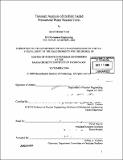| dc.contributor.advisor | Pavel Hejzlar. | en_US |
| dc.contributor.author | Trant, Jarrod Michael | en_US |
| dc.contributor.other | Massachusetts Institute of Technology. Dept. of Nuclear Engineering. | en_US |
| dc.date.accessioned | 2006-07-31T15:18:38Z | |
| dc.date.available | 2006-07-31T15:18:38Z | |
| dc.date.copyright | 2004 | en_US |
| dc.date.issued | 2004 | en_US |
| dc.identifier.uri | http://hdl.handle.net/1721.1/33632 | |
| dc.description | Thesis (S.M.)--Massachusetts Institute of Technology, Dept. of Nuclear Engineering, 2004. | en_US |
| dc.description | Includes bibliographical references (leaves 132-133). | en_US |
| dc.description.abstract | This thesis contributes to the hydride nuclear fuel project led by U. C. Berkeley for which MIT is to perform the thermal hydraulic and economic analyses. A parametric study has been performed to determine the optimum combination of lattice pitch, rod diameter, and channel shape-further referred to as geometry-for maximizing power given specific transient conditions for pressurized water reactors (PWR) loaded with either U02 or UZrH1.6 fuel. Several geometries have been examined with the VIPRE subchannel analysis tool along with MATLAB scripts previously developed to automate VIPRE execution. The transients investigated were a large break loss of coolant accident (LBLOCA), am overpower transient, and a complete loss of flow accident. The maximum achievable power for each geometry is defined as the highest power that can be sustained without exceeding any of the steady state or transient limits. The limits were chosen based on technical feasibility and safety of the reference core and compared with the final safely analysis report (FSAR) of the reference core, the South Texas Project Electric Generating Station (STPEGS), whenever possible. This analysis was performed for two separate pressure drop limits of 29 and 60 psia for both a square array with grid spacers and a hexagonal array with wire wraps. | en_US |
| dc.description.abstract | (cont.) The square core geometry sustaining the highest power (4820.0 MW) for both the hydride and oxide fueled has a pitch of 9.0 mm and a rod diameter of 6.5 mm and was limited by the complete loss of flow accident. Both of these maximum power geometries occurred at the 60 psia pressure drop case. The maximum power of the 29 psia pressure drop case (4103.9 MW) for both fuel types occurred at a pitch of 9.7 mm and a rod diameter of 6.5 mm. The maximum power for the hexagonal arrayed cores occurred at the same hydrogen to heavy metal ratio as the square cores. The hydride fueled core power (5123.2 MW) was limited by the overpower transient while the oxide fueled core power (4996.1 MW) was limited by the overpower transient. The pressure drop constraint was not limiting for either fuel type for either pressure drop case for the wire wrapped cores. | en_US |
| dc.description.statementofresponsibility | by Jarrod Michael Trant. | en_US |
| dc.format.extent | 150 leaves | en_US |
| dc.format.extent | 8575200 bytes | |
| dc.format.extent | 8581535 bytes | |
| dc.format.mimetype | application/pdf | |
| dc.format.mimetype | application/pdf | |
| dc.language.iso | eng | en_US |
| dc.publisher | Massachusetts Institute of Technology | en_US |
| dc.rights | M.I.T. theses are protected by copyright. They may be viewed from this source for any purpose, but reproduction or distribution in any format is prohibited without written permission. See provided URL for inquiries about permission. | en_US |
| dc.rights.uri | http://dspace.mit.edu/handle/1721.1/7582 | |
| dc.subject | Nuclear Engineering. | en_US |
| dc.title | Transient analysis of hydride fueled pressurized water reactor cores | en_US |
| dc.type | Thesis | en_US |
| dc.description.degree | S.M. | en_US |
| dc.contributor.department | Massachusetts Institute of Technology. Department of Nuclear Engineering | en_US |
| dc.contributor.department | Massachusetts Institute of Technology. Department of Nuclear Science and Engineering | |
| dc.identifier.oclc | 64392900 | en_US |
